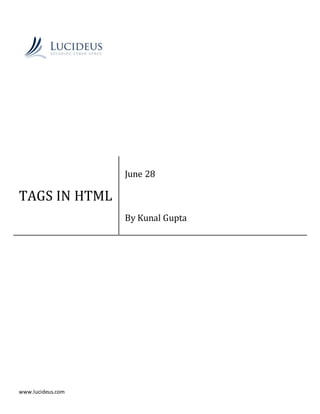
html tags
- 1. www.lucideus.com TAGS IN HTML June 28 By Kunal Gupta
- 2. www.lucideus.com Html (Hypertext markup language) Hypertext markup language is the set of markup symbols or codes inserted in a file intended for a display on a word wide webbrowserpage.The markuptellsthe webbrowserhow todisplayawebpages’swordsandimagesforthe user. Each individual markupcode isreferredtoasan element.Some elementscome inpairsthatindicate whensome display effect is to begin when it is to end. Html elementsformthe buildingblocksof html pages.Html allows images and other objects to be embedded nd it can be used to create interactive forms. It provides a means to create structured documents by denoting structural semanticsfortxtsuch as headings,paragraphs,lists,linksquotesandotheritems.Html elementsare delineatedbytags, writeenusingangle brackets,tagssuchas <img />and <input /> introduce content into pages indirectly. Others such as <p>…..</p> surround and provide information about document text and may include other tag as sub-elements. Browser do not display the html tags, but use them to interpret the content of the page. Markup Html markup consistsof several keycomponents,includingthose calledtags(andtheirattributes),character-baseddata types,characterreferencesandentityreferences.Html tagsmostcommonlycome inpairs like <h1>and</h1>, although some representemptyelementsandsoare unpaired,forexample<img>. The first tag in such a pair is the start tag, and the second is the end tag (they are also called opening tags and closing tags)
- 3. www.lucideus.com TAGS USED IN HTML There are various tags used in HTML such as: DOCTYPE It is represented as “<! DOCTYPE> which defines the document type. The <! DOCTYPE> declaration must be the very first thing in your HTML document, before the <html> tag. The <! DOCTYPE> declaration is not an HTML tag; it is an instruction to the web browser about what version of HTML the page is written in. In HTML 4.01, the <! DOCTYPE> declaration refers to a DTD, because HTML 4.01 was based on SGML. The DTD specifies the rules for the markup language, so that the browsers render the content correctly. For example:
- 4. www.lucideus.com HTML TAG It is represented as <html > and </html>.The <html> tag tells the browser that this is an HTML document .The <html> tag represents the root of an HTML document .The <html> tag is the container for all other HTML elements. For example:-
- 5. www.lucideus.com TITLE TAG The <title> tag is required in all HTML documents and it defines the title of the document. The <title> element: Defines a title in the browser toolbar Provides a title for the page when it is added to favorites Displays a title for the page in search-engine results For example:-
- 6. www.lucideus.com FORM TAG The <form> tag is used to create an HTML form for user input. The <form> element can contain one or more of the following form elements:
- 7. www.lucideus.com <Input>Tag The <input> tag specifies an input field where the user can enter data. <input> elements are used within a <form> element to declare input controls that allow users to input data .An input field can vary in many ways, depending on the type attribute.
- 8. www.lucideus.com <Text area>TAG The <Text area> tag defines a multi-line text input control. A text area can hold an unlimited number of characters, and the text renders in a fixed-width font (usually Courier).The size of a text area can be specified by the column and rows attributes, or even better; through CSS' height and width properties.
- 9. www.lucideus.com <Button>TAG The <button> tag defines a clickable button. Inside a <button> element you can put content, like text or images. This is the difference between this element and buttons created with the <input> element.
- 10. www.lucideus.com <Select>TAG The <select> element is used to create a drop-down list. The <option> tags inside the <select> element define the available options in the list.
- 11. www.lucideus.com <Option>TAG The <option>tag defines an optionin a select list. <option> elements go inside a <select> or <data list> element.
- 12. www.lucideus.com <Field set>TAG The <field set> tag is used to group related elements in a form. The <field set> tag draws a box around the related elements.
- 13. www.lucideus.com <label>TAG The <label> tag defines a label for an <input> element. The <label> element does not render as anything special for the user. However, it provides a usability improvement for mouse users, because if the user clicks on the text within the <label> element, it toggles the control. The for attribute of the <label> tag should be equal to the id attribute of the related element to bind them together.
- 14. www.lucideus.com CODING OF CALCULATOR IN HTML:-
